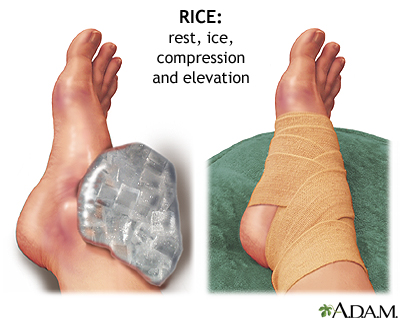Health Library
Sprains
Joint sprain
A sprain is an injury to the ligaments around a joint. Ligaments are strong, flexible fibers that hold bones together. When a ligament is stretched too far or tears, the joint will become painful and swell.
Images

Presentation

I Would Like to Learn About:
Causes
Sprains are caused when a joint is forced to move into an unnatural position. For example, "twisting" one's ankle causes a sprain to the ligaments around the ankle.
Symptoms
Symptoms of a sprain include:
- Joint pain or muscle pain
- Swelling
- Joint stiffness
- Discoloration of the skin, especially bruising
First Aid
First aid steps include:
- Apply ice right away to reduce swelling. Wrap the ice in cloth. Do not place ice directly on the skin.
- Wrap a bandage around the affected area to limit movement. Wrap firmly, but not tightly. Use a splint if needed.
- Keep the swollen joint raised above your heart, even while sleeping.
- Rest the affected joint for several days.
- Avoid putting stress on the joint because it can make the injury worse. A sling for the arm, or crutches or a brace for the leg can protect the injury.
Aspirin, ibuprofen, or other pain relievers can help. DO NOT give aspirin to children.
Keep pressure off the injured area until the pain goes away. Most of the time, a mild sprain will heal in 7 to 10 days. It may take several weeks for pain to go away after a bad sprain. Your health care provider may recommend crutches. Physical therapy can help you regain motion and strength of the injured area.
When to Contact a Medical Professional
Go to the hospital right away or call 911 or the local emergency number if:
- You think you have a broken bone.
- The joint appears out of position.
- You have a serious injury or severe pain.
- You hear a popping sound and have immediate problems using the joint.
Call your provider if:
- Swelling does not start to go away within 2 days.
- You have symptoms of infection, including red, warm, painful skin or a fever over 100°F (38°C).
- The pain does not go away after several weeks.
Prevention
The following steps may lower your risk for a sprain:
- Wear protective footwear during activities that place stress on your ankle and other joints.
- Make sure that shoes fit your feet properly.
- Avoid high-heeled shoes.
- Always warm-up and stretch before doing exercise and sports.
- Avoid sports and activities for which you have not trained.
References
Biundo JJ. Bursitis, tendinitis, and other periarticular disorders and sports medicine. In: Goldman L, Schafer AI, eds. Goldman-Cecil Medicine. 26th ed. Philadelphia, PA: Elsevier; 2020:chap 247.
Geiderman JM, Katz D. General principles of orthopedic injuries. In: Walls RM, Hockberger RS, Gausche-Hill M, eds. Rosen's Emergency Medicine: Concepts and Clinical Practice. 9th ed. Philadelphia, PA: Elsevier; 2018:chap 42.
Wang D, Eliasberg CD, Rodeo SA. Physiology and pathophysiology of musculoskeletal tissues. In: Miller MD, Thompson SR. eds. DeLee, Drez, & Miller's Orthopaedic Sports Medicine. 5th ed. Philadelphia, PA: Elsevier; 2020:chap 1.
BACK TO TOPReview Date: 5/3/2021
Reviewed By: Linda J. Vorvick, MD, Clinical Associate Professor, Department of Family Medicine, UW Medicine, School of Medicine, University of Washington, Seattle, WA. Also reviewed by David Zieve, MD, MHA, Medical Director, Brenda Conaway, Editorial Director, and the A.D.A.M. Editorial team.
 | A.D.A.M., Inc. is accredited by URAC, for Health Content Provider (www.urac.org). URAC's accreditation program is an independent audit to verify that A.D.A.M. follows rigorous standards of quality and accountability. A.D.A.M. is among the first to achieve this important distinction for online health information and services. Learn more about A.D.A.M.'s editorial policy, editorial process and privacy policy. A.D.A.M. is also a founding member of Hi-Ethics. This site complies with the HONcode standard for trustworthy health information: verify here. |
The information provided herein should not be used during any medical emergency or for the diagnosis or treatment of any medical condition. A licensed medical professional should be consulted for diagnosis and treatment of any and all medical conditions. Links to other sites are provided for information only -- they do not constitute endorsements of those other sites. © 1997- 2021 A.D.A.M., a business unit of Ebix, Inc. Any duplication or distribution of the information contained herein is strictly prohibited.
